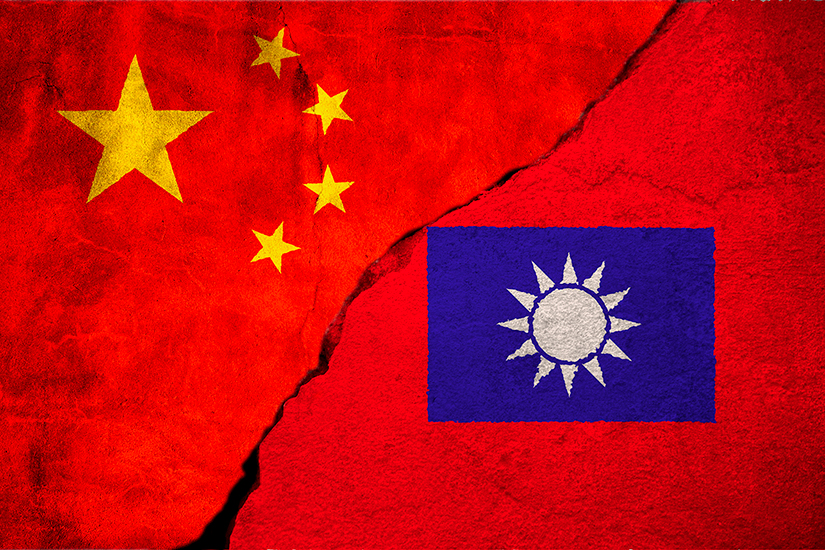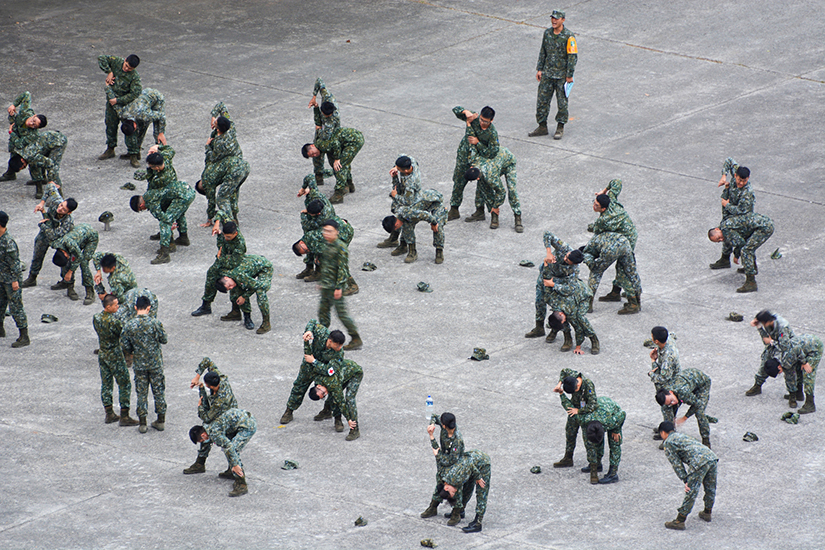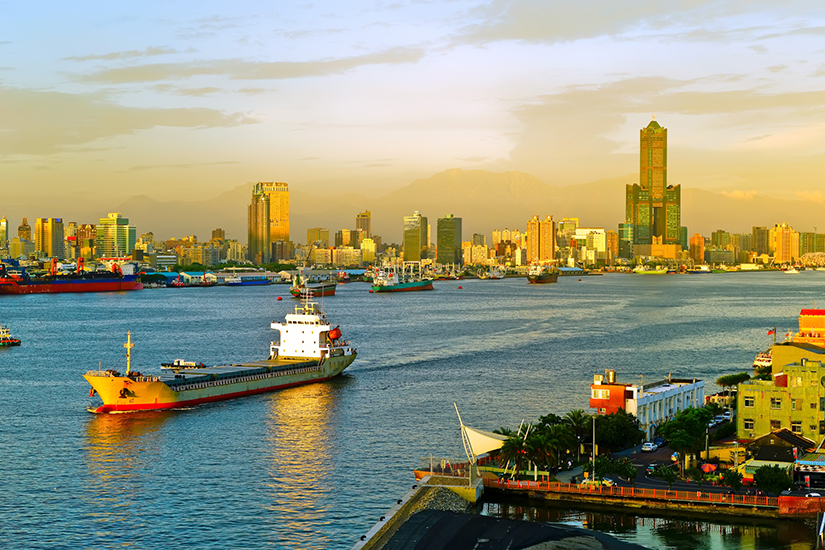We don’t have a fair say to decide war and peace for the drastic difference in comprehensive national power between the two sides of the Taiwan Strait and the totalitarian essence of the PRC regime.
However, we at least have the strength to prevent the inclination towards war, and namely, dissuade the enemy to wage war on considering its potential cost.
These are the words of Minister of National Defense Chiu Kuo-cheng featured in the foreword of the ROC National Defense Report 2023 [1] published by Taiwan on September 12, 2023. The National Defense Report is equivalent to the Defense of Japan (Annual White Paper) in Japan and has been published by the Republic of China Ministry of National Defense every second year since 1992 under the Lee Teng-hui administration. It is considered to be one of the most authoritative government reports for evaluating the national defense policies and military strategies of Taiwan and the comprehensive military power of China. [2] Government reports such as the Defense of Japan and the National Defense Report are explanations seeking the understanding of the citizens, who are the people with sovereignty and the taxpayers, and at the same time they are also tools seeking understanding from the international community regarding the legitimacy of the claims of a country. Then, what claims is Taiwan making to the international community?
The message being promoted by the current National Defense Report is summarized in the words of Defense Minister Chiu at the beginning of the report. What those words mean is that in China-Taiwan relations only China, not Taiwan, has the power to decide to start a war, and all that Taiwan can do is endeavor to dissuade China from war. Moreover, it is a message which promotes to the international community the idea that Taiwan is a state and society which deserves to receive assistance.
The power to decide to start a war is on the China side
The first major change which has occurred since 2021, when the previous National Defense Report [3] was published, and before the publication of the current report, was the start of the war in Ukraine due to the military invasion by Russia. Learning the lesson of the invasion of Ukraine by Russia, Defense Minister Chiu wrote in his comments in the foreword that “a totalitarian regime can ignore international rules and kick off invasion for the sake of its own national interests or political assertions.” Then in Chapter 1, Strategic Environment, the report states that Taiwan “will not escalate tensions or provoke, with the primary goal of maintaining cross-strait peace and stability” and therefore whether or not China uses force against Taiwan depends on the will of President Xi Jinping, who has repeatedly stated that he will not renounce the use of force against Taiwan. [4] The report also warned that an invasion of Taiwan by China could occur regardless of the intentions of Taiwan.

Secondly, as Defense Minister Chiu also stated in his foreword comments, Taiwan is “met with relentless and substantive threats of military invasion from the PRC,” so there is the serious recognition that the behavior of China, which has the intention and capability to make the decision to use force against Taiwan, has already become normalized. In Chapter 2, Security Challenges, the report analyzes the threat of China more specifically. The first point which should be noted is that China is advancing the verification of feasible operations by repeatedly conducting a variety of exercises predicated on a “Taiwan invasion operation,” including landing operations mobilizing civilian aircraft, ships, and other vehicles [5] and cognitive warfare using the media and the Internet. Moreover, the report expressed the perception that the hybrid warfare of China using a variety of military and non-military methods in the grey zone has already become normalized, and pointed out that China is unilaterally changing the status quo in the Taiwan Strait and escalating tensions in the region, and is attempting to drive a wedge in the relationship between the government and the citizens inside Taiwan and the relations between Taiwan and the international community.
Deterrence of war using all-out defense
The fact that the war in Ukraine has become a prolonged war lasting longer than one year, contrary to President Putin’s initial scheme, is suggestive in terms of deterrence and countermeasures for Taiwan. Keeping in mind the fact that Ukraine has fought well and the war has been prolonged due to the resistance of Ukrainian citizens, Defense Minister Chiu stated in his foreword comments that “even a totalitarian regime may fear wading deeper into a quagmire of war, like Putin’s nightmare” and that Taiwan should “avert war by preparing for it, be capable of fighting a war to stop it” and mentioned that the Taiwanese military has advanced the building of its multi-domain deterrence and denial capabilities and further enhanced the resilience of the defense systems of the society and the nation.
Regarding the former, in Chapter 4, Development of Capabilities, the report discusses in detail the building of the asymmetric warfare potential of the Taiwanese military utilizing the geographical advantages of the Taiwan Strait and the enhancement of the resilience of the execution of operations with decentralized command and control functions, and, taking into consideration the lack of depth of the national territory, it emphasizes “greater mobility, miniaturization, the introduction of unmanned equipment, and the introduction of AI” for military equipment.
Furthermore, regarding the latter, in Chapter 5, Revising Conscription Term, the report emphasizes the extension of the compulsory military service period, [6] proceeding with the division of roles between the active forces and the reserve forces, and so forth, and in Chapter 6, Refining Reserve Reform, the report emphasizes responding with “all-out defense” [7] with the united cooperation of not only the Taiwanese military but also the public, local governments, companies, and other actors. In particular, regarding methods of response by the general public in the case that an invasion by China has occurred, the report describes in detail how Taiwan has issued the All-out Defense Handbook, [8] which comprehensively covers preparation at peacetime, evacuations, identifying friend or foe, acquiring accurate information, among other things. The report also describes in detail the measures reflecting the lessons learned from the war in Ukraine, including mobilization exercises with the participation of the public and companies as well as promotion of the domestic production of military aircraft and warships and other armaments, diversion of civilian factories for military use, and expansion of their production capacity, in order to enhance the ability of Taiwan to continue fighting in an emergency.

The entire report sends the clear message that Taiwan “will not yield an inch of [its] sovereign lands and will be unwavering in upholding democracy and freedom” (foreword comments) due to the united efforts of not only the military but all the citizens, even if an invasion of Taiwan by China were to become a reality.
Expectations of and appeals to the international community
The war in Ukraine has reminded us that the support and assistance of the international community is essential to protect a nation from invasion. As stated above, this is because it is self-evident that although Taiwan is resolutely maintaining a posture of pursuing self-reliant defense, it cannot eliminate the threat from China with only its own efforts. Moreover, in Taiwan there is no framework for collective defense like the Japan-U.S. Alliance or NATO, and the United States on which Taiwan had been relying does not deny the “strategic ambiguity” regarding the defense of Taiwan. In addition, recently there has been the view that the commitment of the United States to its allies and partners could change depending on the trends in the domestic politics of that country.[9]Considering that concerns regarding the uncertainty of military assistance by the United States in formal allies such as Japan and South Korea cannot be dispelled, it should be no wonder if the concerns of Taiwan are even more serious.[10]
For that reason, the National Defense Report promotes the point that Taiwan has value from the perspective of the international community which should be protected and assisted. The foreword comments emphasize that Taiwan is “a linchpin to contain the People’s Republic of China’s (PRC) eastward maritime power expansion to the Pacific,” that politically Taiwan is at “the frontline of democracy confronting authoritarianism,” and that historically it “has been intertwined with bilateral relations of the Taiwan Straits and international communities.” After this in Chapter 1, Strategic Environment, it presents the value of Taiwan for the international community as follows.
Firstly, Taiwan is located at an important position in relation to the geographical strategy called the first island chain of the Indo-Pacific region. Specifically, the report pointed out that (i) The Bashi Channel near Taiwan and Japan’s Miyako Strait are important strategic waterways for China to pass through the first island chain and (ii) Taiwan is an essential traffic route for heading to and from Southeast Asia, Northeast Asia, the United States, and Canada. For example, approximately 50% of all freighters in the world pass through the Taiwan Strait, and there are 18 important flight routes in the Taipei Flight Information Region.[11] The report thus emphasized that the peace and stability of Taiwan (Strait) is tightly linked to global economic development.

Secondly, Taiwan is a reliable partner in the Indo-Pacific region which staunchly supports and abides by all international norms. In particular, the report presented the examples that Taiwan (i) is committed to keeping a democratic, diverse, and humane way of life, (ii) will not escalate tensions or provoke, with the primary goal of maintaining cross-strait peace and stability, and (iii) on issues in the South China Sea will cooperate with the countries in the region in accordance with international law. The report thus emphasized that the peace and stability of Taiwan (Strait) is extremely important for the peace and stability of the region.
In addition, the report emphasized that Taiwan would (i) strengthen its overall defense capabilities to maintain security in the surrounding areas of the Taiwan Strait and free passage of both air and sea lines in order to maintain the status quo in the Taiwan Strait, which is vital to regional peace and stability, (ii) actively take part in international organizations to provide humanitarian assistance as a responsible risk manager of global risks (such as COVID-19), and (iii) join hands with like-minded allies, based on the principle of maintaining peace, stability, and mutual benefits, to staunchly defend [its] free and democratic way of life.
Whereas the previous National Defense Report consistently emphasized a democratic and free society, an open economy, and advanced information technology, the current report emphasizes that Taiwan is on a strategically important international traffic route for other countries and the international community, and staunch defense of the existing order including international law. We can conclude that this change probably reflects the view that there could be different degrees of enthusiasm in the positions of the members of international community in the event of an emergency involving Taiwan, based on the fact that different degrees of enthusiasm have been seen in each country for assistance from the West since Russia’s invasion of Ukraine and the fact that some in the so-called Global South tolerate Russia’s actions.
Conclusion
Through the National Defense Report, Taiwan has emphasized its self-help efforts for its own defense, while also emphasizing the significance of Taiwan for the international community as a strategic move aimed at obtaining the assistance of the international community in an emergency. The background to this is a sense of crisis that the threat of China has emerged and the perception that the good fight by Ukraine was made possible because it received the assistance of the international community. We must not overlook the fact that this applies to Japan as well. For example, there is much room to promote the value of Japan to the international community, such as by carefully explaining the strategic significance of defense of the southwestern region, and to devise ways to attract the international community as an ally.
(2023/12/25)
Note
- 1 Ministry of National Defense of the Republic of China, “ROC National Defense Report 2023,” September 2023.
- 2 Rira Momma, “Does ‘Taiwan Can Help’ Apply to Taiwan Itself? Taiwan’s Assessment of the People’s Liberation Army’s Joint Operations against Taiwan and the Development of Taiwan’s National Defense System,” Security & Strategy, Volume 2, Number 2, March 2022, pp. 1-22.
- 3 Ministry of National Defense of the Republic of China, “Past National Defense Reports Section.”
- 4 In China, not only President Xi Jinping but also many national leaders and state-run media organizations have repeatedly announced that China does not renounce the use of force against Taiwan.
- 5 Katsuya Yamamoto, “The Unknown Fear of China’s ‘Military-Civilian Fusion’ which Japan Should be Wary of: Civilian Car Ferries Can be Used for Assault Landings at Any Time,” Toyo Keizai Online, November 19, 2021.
- 6 In 2018 Taiwan changed to a military service system based on volunteer soldiers which retained four months of compulsory military training (military conscription), but as a consequence of changes in the situation the compulsory period for military training will be extended to one year from 2024 onward. It is estimated that due to this, for the five years from 2024, the number of men who are serving the one year of compulsory service will increase from 9,000 to 53,000 every year.
- 7 This is equivalent to the “civil protection” in Japan. (Cabinet Secretariat, Civil Protection Portal Site) In the case of China, refer to Katsuya Yamamoto, “The Revitalization of Renmin Fangkong (Civil Air Defense), China’s Civil Protection: A Barometer of Xi Jinping’s Resolve in Preparation for Armed Conflict with the United States,” International Information Network Analysis (IINA), June 19, 2023.
- 8 All-Out Defense Contingency Handbook Section. At the All-out Defense Mobilization site, preparations have been made so that handbooks the general public can understand easily, including handbooks for all citizens and specialized for each municipality, and English versions, can be obtained. Furthermore, these handbooks have an item on “identifying friend or foe” and clearly present in color the uniforms of members of units engaged in rescuing victims such as the Taiwanese military, police, firefighters and the combat uniforms and insignia, etc. of the People’s Liberation Army, the enemy.
- 9 Jeffrey W. Hornung, et al., “Like-Minded Allies? Indo-Pacific Partners’ Views on Possible Changes in the U.S. Relationship with Taiwan,” RAND Corporation, 2023.
- 10 “Do Taiwanese public believe the United States will send troops to defend Taiwan if China invades?” (Public Opinion Poll), Taiwanese Public Opinion Foundation, February 21, 2023. In polls since the invasion of Ukraine by Russia, the percentage of people who think that the US military would send troops to the Taiwan Strait to defend Taiwan has greatly decreased, but that percentage has finally recovered to just over 40% as of this poll.
- 11 A flight information region (FIR) is airspace where the International Civil Aviation Organization (ICAO) decides the division of duties among each country providing air traffic services, and is a different concept from territorial airspace or an air defense identification zone (ADIZ). Most of the territorial airspace of Japan and some of the northeast Pacific Ocean is under the jurisdiction of the Fukuoka FIR and controlled by the Ministry of Land, Infrastructure, Transport and Tourism (the Fukuoka Air Traffic Control Center), but the area west of the 124 degrees east longitude line which passes between Ishigaki Island and Iriomote Island and near to the eastern end of Kohama Island are in the control area of the Taipei FIR.

